The Coolest Ear Piercing Placements, According to the Pros

Getty Images
Your ear is the ultimate creative canvas. Ear-piercing placements have come a long way in the last couple of decades, with nearly every external area of the organ demanding adornment. The best part about building a collection of ear piercings is the potential for personalization, with unique placements and jewelry merging for a look that’s entirely yours. “It's a beautiful form of self-expression that can have endless possibilities,” says Kelly Hurt, store manager at Brooklyn’s Pamela Love.
For some, ear artistry may come down to a constellation of piercings around the lobe, while others may opt for jewelry that travels up and around the ear. “I'm a huge fan of asymmetry and having a unique setup on each ear,” says Alaina Rothstein, founder of Leo West in Los Angeles. “I always say about my two ears: ‘She’s a little bit classy,’ then turning my head, ‘and she's a little bit sassy.’"
As multi-tiered ear piercings gain in popularity, placements have become increasingly creative. “These days, people are a lot more open to spots that aren’t regularly pierced,” says piercing artist Adrian Castillo. Castillo notes that considering your lifestyle when selecting your piercings is essential, as your accessories should never be a chore or inconvenience. “Piercings should elevate how we feel about ourselves or elevate our look in a very subtle way,” he says. Every ear is different, so analyzing your own is a perfect place to start. “I love doing piercings that highlight something different or unique about a client's ear, turning what could be viewed as a flaw or defect into something beautiful and empowering,” says Rothstein. “Sometimes the smallest dainty pierces can make the biggest statement when styled in fun and interesting ways.”
Read on for 13 ear-piercing placements worth considering.
13 Ear Piercing Placements
Lobe
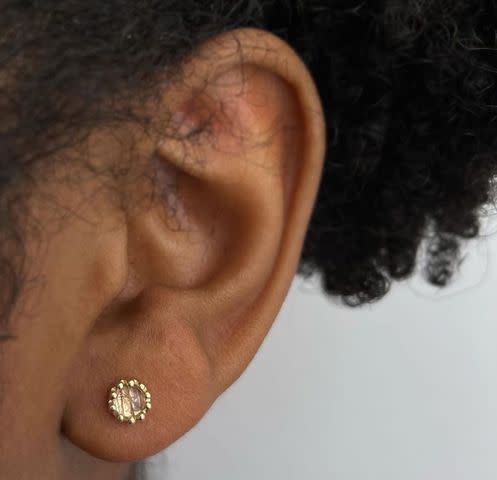
It all began with the lobe. This classic piercing placement serves as the foundation for the rest of your look and is also (generally speaking) one of the most painless options of the bunch. After you select your stud, expect a quick pinch and roughly three to five months of healing.
Stacked Lobe
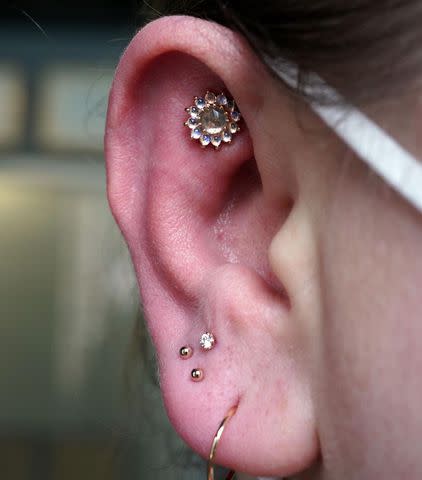
If doubling or tripling up on the lobe isn’t doing it for you, try stacking, or adding a piercing just above an existing hole. “I do a lot of stacked piercings, utilizing old holes on a lobe that were maybe done a little low and adding a fresh new one above it to make the placement look like it’s on purpose,” says Castillo. Embracing this non-linear mindset allows for a wealth of possibilities, including constellation clusters. “Constellations are a set of dainty piercings that create a star-like pattern,” says Rothstein. “They are most common on the lobe but can also be done on the flat as well.”
Conch
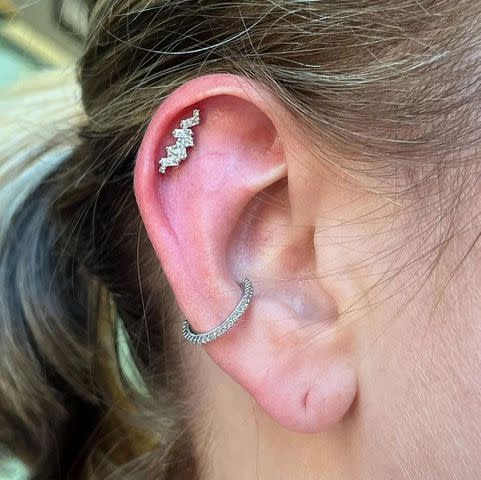
“The conch is so cute and trendy,” says Rothstein. Conch piercings sit on the inner “concha” of the ear just above where the lobe turns to cartilage. They're a piercer favorite. “We never stop recommending this piercing to new or experienced piercing clientele,” says Star Ellis, founder of Nine Moons Piercing. In addition to endless jewelry options and some placement variations you can play with, expect minimal healing time as compared to other cartilage piercings. “Since the placement of this piercing is tucked away along the inner conch, people generally find this piercing easier to heal as it’s less prone to getting snagged externally,” Isaacs says. (Think: 6 months as opposed to 12.)
Flat
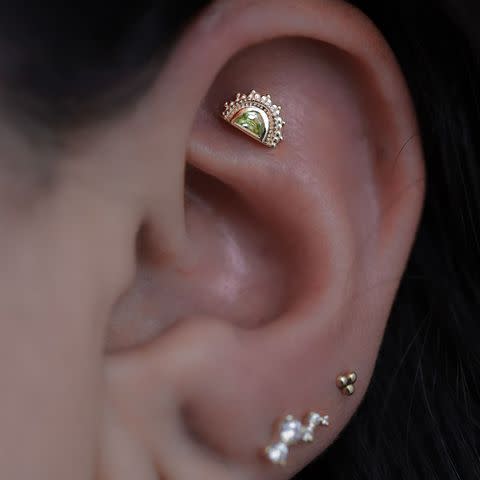
All of our piercing artists report that flat piercings are among the placements of the moment. “This piercing is placed in the flat region of cartilage in the upper ear and is great to balance out your earscape," Isaacs says. As with the lobe, stacking and clustered constellations are possible here — anything to make the most of the available surface area.
Helix
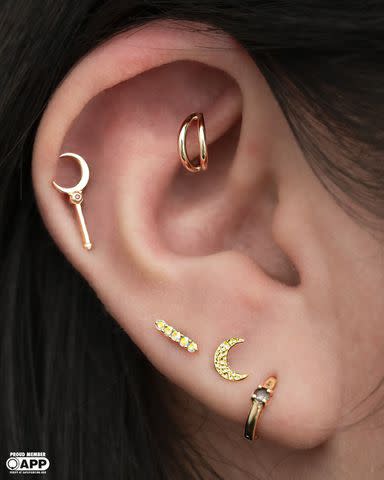
The helix is the official term for the classic cartilage placement. This go-to option has been reimagined over the years, with multiple piercings placed together (known as a double or triple helix) or placed slightly lower on the cartilage (a mid helix). Though this placement is fairly accessible, it’s still a cartilage piercing, so plan on some pressure during execution and a fair amount of recuperation time. “Healing can seem quick, but being cartilage it will still take 6+ months to fully heal,” Ellis says.
Forward Helix
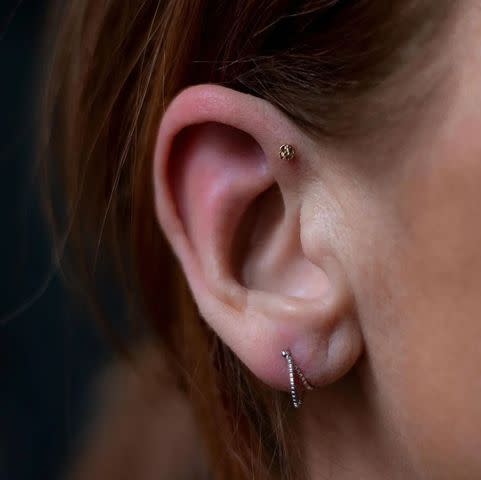
A forward helix is the foil of the original, positioned on the cartilage at the ear’s upper interior. The small flap provides room for a maximum of two piercings, but one is more common.
Daith
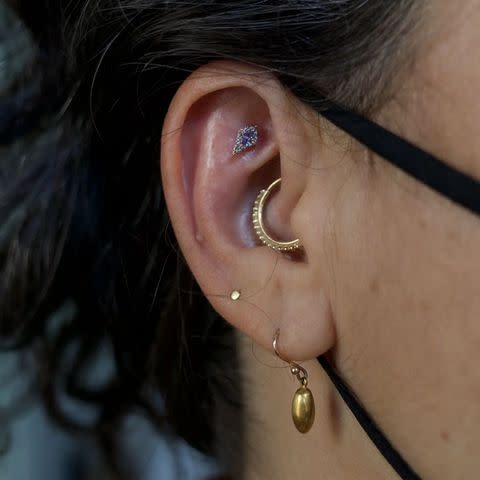
This is where we start getting into the folds. The daith is a piercing through the ear's innermost cartilage, also called the "crux" of the helix. "Daith" is derived from the Hebrew word for knowledge, and the piercing is thought to ease chronic headaches and migraines (though more evidence is needed to support this claim). Due to its placement, the daith is among the only piercings that can call for a ring from the start. It's also one of the more uncomfortable pierce points, and (like all cartilage piercings) it's prone to infection, so be sure to cleanse well!
Rook
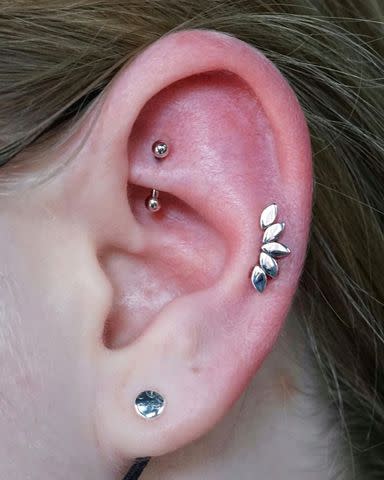
Just above the daith, you'll find the rook. “This is a cartilage piercing located in the uppermost ridge of your inner ear,” says Isaacs. The rook is a touch less popular than the daith or tragus, but adds a similar amount of visual interest to your adorned ear. As noted above, be sure to prioritize aftercare of your rook.
Tragus
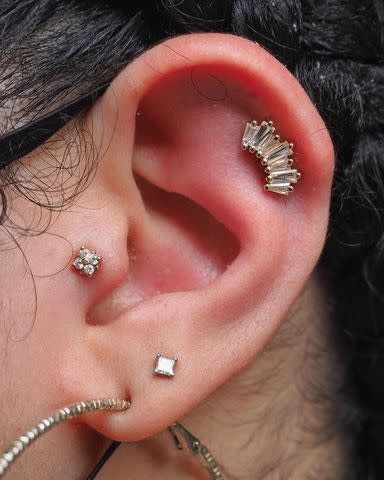
“The tragus piercing is located in the region of the cartilage that sits right in front of the ear canal,” says Isaacs.
Anti-Tragus
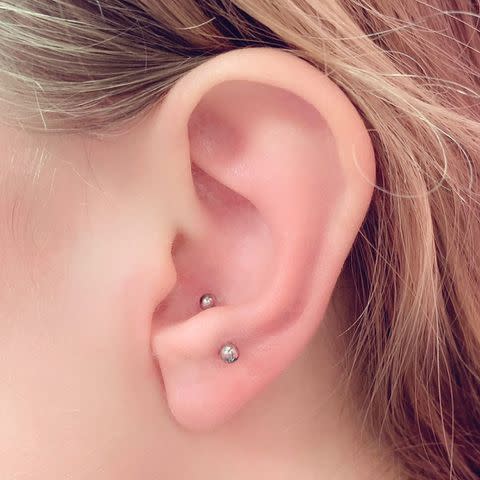
As its name indicates, the less common anti-tragus is positioned adjacent to the tragus on the small flap of cartilage above the lobe. This piercing can function the same way as a stacked lobe, creating a clustered feel.
Industrial
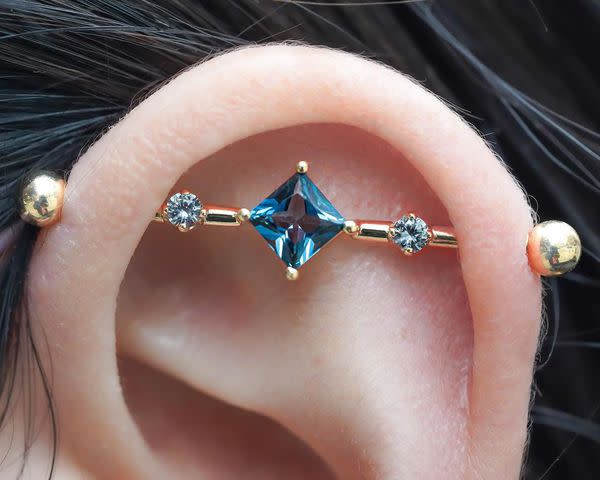
Those with a flair for the dramatic are bound to swoon over the industrial. This two-part piercing crosses through the ear’s topmost cartilage with the holes connected by a bar (straight, curved, or triangulated) or chain. A bonus: Should you ever tire of the cut-across look, each of the industrial’s holes can also serve as a standalone piercing, ideal for smaller bars and hoops.
Orbital
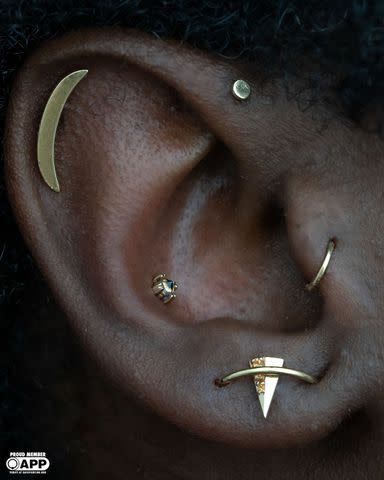
An orbital repurposes a "double piercing" on the lobe to make a single statement with a connecting piece of jewelry. Orbitals can technically be located anywhere on the ear, so long as two closely positioned placements are connected by a single earring.
Pain Thresholds and Healing Times
As the act of piercing comes down to poking a hole in your ear, pain followed by a period of healing is to be expected. Beginning with piercers who are committed to quality in process and materials is the first step to a successful appointment. “Studs-only pierces with implant-grade titanium or 14K gold piercing jewelry for optimal healing and comfort — for all piercing locations — offers expert ear piercings with needles (never piercing guns!) for better precision, safety, and healing,” says Sam Isaacs, associate director of brand management at Studs. Expect to start with a stud earring (with some placement exceptions, including the daith) and to wait 2-3 months before changing out your jewelry.
After placement selection and setup, the actual piercing part is pretty quick — as in seconds. While momentary discomfort may come with difficult-to-access areas, the pain can be described as a pinch or a bit of pressure. Ultimately, pain tolerance is just as personal as your assemblage of earrings. “Some people just have it and others don’t,” says Castillo. “I’ve seen lobes feel like they were killing someone and I’ve seen cartilage be the easiest thing.” Piercing artist Roze Rahim of New York’s Nine Moons Piercing suggests taking a deep breath in and out when your piercer recommends doing so. “It really helps reduce the sensation of a piercing,” she says.
Healing times are slightly more uniform, but may shift based on your lifestyle and commitment to care. “Healing times vary and are dependent on factors such as your overall health, the amount of sleep you get, stress levels, and your aftercare regimen,” says Isaacs. “Typically, ear lobe piercings take around 4-6+ months, while upper or inner ear piercings take between 6-12+ months to fully heal.” Proper cleansing (twice a day with warm water and antibacterial soap) and not sleeping on your new piercing will help to minimize irritation and the potential for infection, getting you closer to swell-free comfort — and your ear-aesthetic goals. "Patience is key during the healing process! Changing the piercing jewelry too early can disrupt the healing process and set you back," says Hurt. "It's a good idea to follow up with a piercer when you're wanting to change the piece you were pierced with." And as every placement is unique, be sure to follow any aftercare instructions provided by your piercing artist.
For more InStyle news, make sure to sign up for our newsletter!
Read the original article on InStyle.


